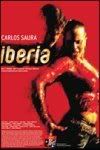IBERIA: Strictly Spanish Dances
IBERIA (dance documentary in Spanish)
Cast: Sara Baras, Antonio Canales, Manolo Sanlucar and Enrique Morente
Director: Carlos Saura
Time: 85 mins
Rating: * * 1/2 (out of 4) 
WHAT’S THE BIG DEAL? First off, let me say that this documentary on Spanish dances and culture is not for the average cinema-goer. There is no plot or narration to bind the various dance sequences together – or any familiar names that would attract the local crowd. However, if you are a student of music and dance, like the Flamenco or tap dancing, you may find “Iberia” inspiring and even entertaining enough to start your feet tapping to the music.
WHAT’S IT ABOUT? “Iberia”, written and directed by veteran film-maker Carlos Saura, is a tour-de-force, celebrating the discipline, skill and passion of Flamenco, classical music, ballet and contemporary dance. Working with some of the greatest Spanish talents, Saura has succeeded not only in drawing the best from each of them, but in raising their standard of performances to new heights. Most of the dance segments appear like rehearsals and impromptu performances. Others, using mirrors and delayed screen images, allow us to study every nuance and gesture of the performers.
According to the production notes, “Iberia” is inspired by the work of Spanish composer Isaac Albéniz (1860-1909). Saura’s camera sometimes takes the point of view of one of the performers – in preparations, rehearsals, and the gradual birth of the acts – and he conjures a dramatic and compelling universe, a world of passion and creativity. His “Iberia” shows the musical where the story to be told is already contained in the music, and taking for granted that its audience are more or less familiar with.
HIGHLIGHTS & LOWLIGHTS: In short, the documentary is geared mainly towards Spanish-speaking audiences and there is nothing in the form of subtitles to explain what is going on (the history or background of the dances) to foreign viewers. This leaves us to deduce or guess the story or 'message' in the dances. For some, this can be rather bewildering but for those who follow the movements and costumes closely, there can be rather fascinating discoveries.
In segments like 'Bajo la Palmera' and 'Granada', we see dancers silhouetted against bright orange or red backgrounds, providing an experimental, surrealistic effect. In others, Saura recognises Arabic and Muslim influences in Spanish culture, and there is even a musical number performed by old native women. 'Alemaria', however, features a modern sequence with two groups of youngsters facing-off like rival gangs in “West Side Story”. One of them even adds some break dance moves to his repertoire – taking the performance into the realm of contemporary campiness.
The credits name Sara Baras, Antonio Canales, José Antonio, Aida Gómez and Patrick De Bana among the lead dancers and choreographers, and the musicians include Manolo Sanlúcar, Gerardo Núñez and José Antonio Rodríguez; pianist Rosa Torres Pardo and Chano Domínguez and flamenco-jazz star Jorge Pardo. However, these stars are not identified on-screen in their segments – and we are left to another round of guesswork on these personalities.
THE LOWDOWN: Completed in 2005, “Iberia” was apparently not meant for international release. If it were, the producers should have included a whole lot of subtitles and clarification so that people like us can understand and enjoy the documentary a whole lot more.

0 Comments:
Post a Comment
<< Home